Special Report
35 Billion-Dollar Weapons in the 2024 US Military Budget
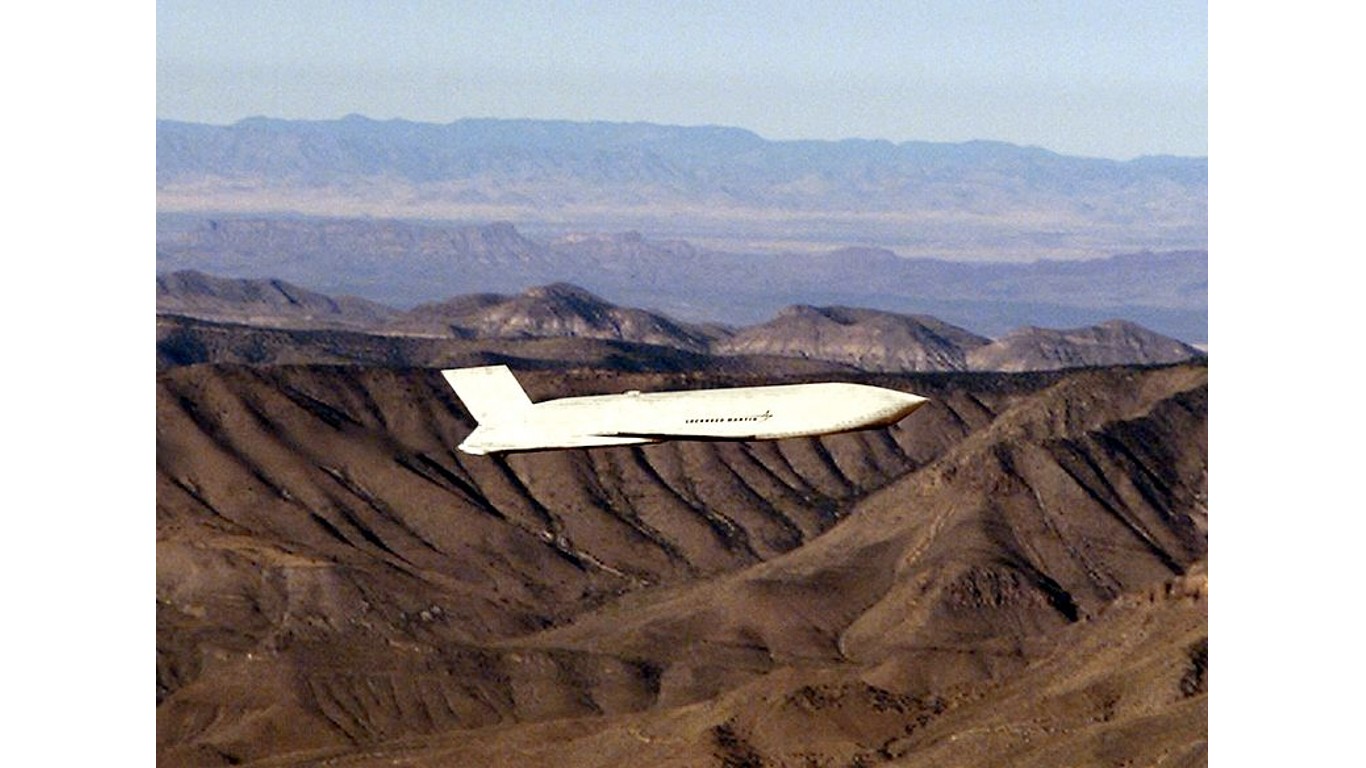
Published:
Last Updated:

Tensions between the U.S. and China have been mounting for years, and with China’s recent militarization of several islands in the South China Sea, some U.S. officials fear an attack on Taiwan is imminent. The U.S. Department of Defense has responded to China’s rapid military expansion – which hints at plans to project its power beyond its own borders – with a 2024 defense budget request that aims to maintain the U.S.s military advantage over China.
The $842 billion budget exceeds the fiscal year 2023 budget by $26 billion and the 2022 budget by $100 billion. A statement released by U.S. Secretary of Defense Lloyd J. Austin III states that this budget reflects the department’s “largest ever investments in readiness and procurement” as well as the “largest ever request for the Pacific Deterrence Initiative, which we are using to invest in advanced capabilities, new operational concepts, and more resilient force posture in the Indo-Pacific region.”
The total budget includes a weapons funding request totaling $315 billion. Some of the largest weapons allotments are $61.1 billion to aircraft systems, $48.1 billion to shipbuilding and maritime systems, and $30.6 billion to missiles and munitions. (See how China and the world’s top military spenders compare to the U.S.)
To identify the billion dollar weapons the U.S. military will spend the most on next year, 24/7 Wall St. reviewed the DoD’s recently-released Fiscal 2024 Budget Request. Each of the weapon systems on this list has a planned investment of over $1 billion in fiscal year 2024.
The spending totals include both procurement costs (purchasing completed weapons systems) as well as research, development, test, and evaluation, and the costs of modifying and otherwise upgrading existing weapons systems. The quoted descriptions of the spending, as well as the breakdown as to where in the military each system will go, comes directly from the DoD budget proposal, from the Program Acquisition Cost By Weapons System document.
These weapons include missile defense systems, tactical vehicles, aircraft, submarines, and surface naval vessels. Some weapons allotments are also budgeted for cybersecurity defense systems, a space-based missile warning system, and chemical weapon demilitarization. The latter includes a program to destroy former U.S. chemical weapon production facilities and safely dispose of America’s chemical weapon stockpiles in compliance with the 1997 Chemical Weapons Convention treaty. Here are 10 horrifying chemical weapons and the wars they were used in.
Click here to see 35 billion-dollar weapons in the 2024 US military budget.
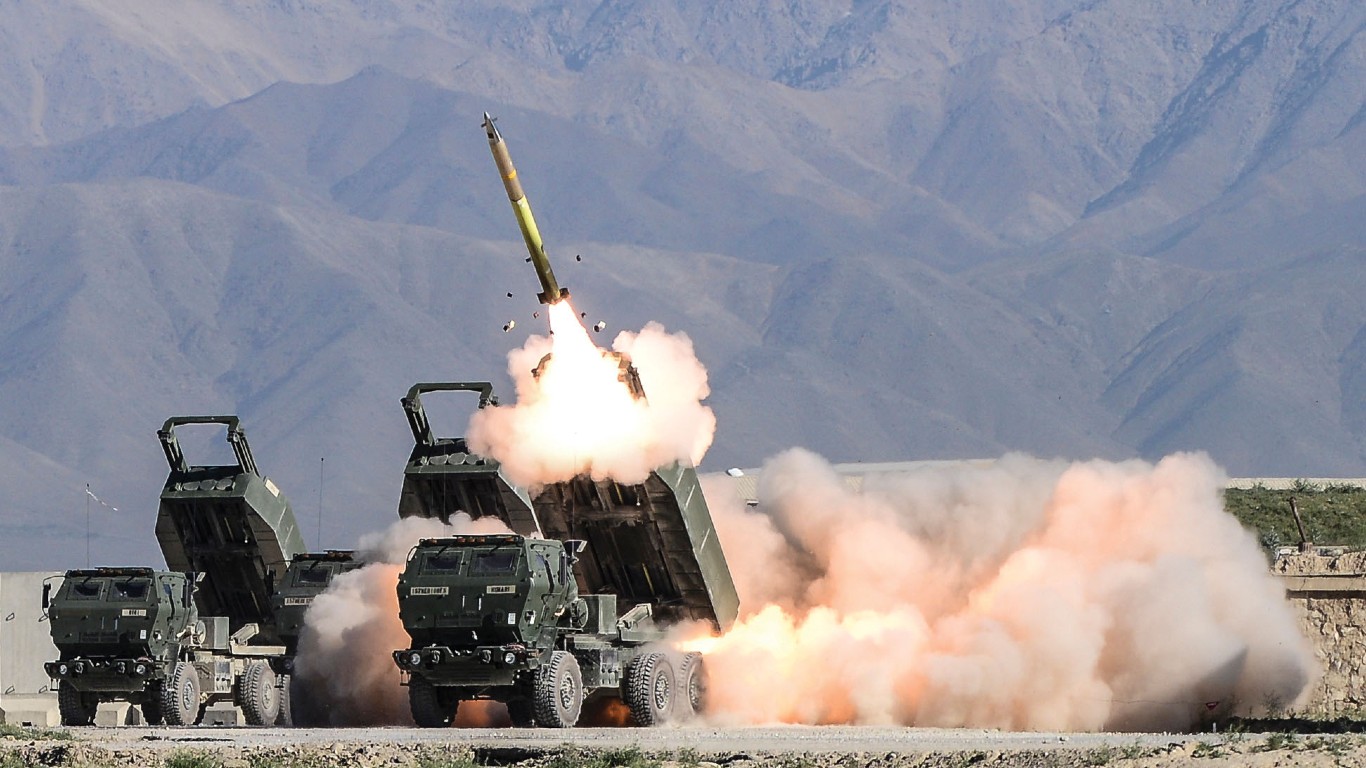
35. GMLRS Guided Multiple Launch Rocket System
> Requested budget for 2024: $1.0 billion
> Spending, FY2023: $1.3 billion
> Requested acquisitions, FY2024: 5,064 units (5,016 for Army, 48 for Navy)
> Acquisitions, FY2023: 5,954 units (5,910 for Army, 44 for Navy)
> Service branches: Army
> Primary contractor(s): Lockheed Martin Corporation
Department of Defense: “Continues production of current rocket variants, and development/qualification of modifications to extend the maximum range and enhance warhead effectiveness.”
[in-text-ad]

34. LRASM Long Range Anti-Ship Missile
> Requested budget for 2024: $1.1 billion
> Budget for 2023: $549.5 million
> Requested acquisitions, FY2024: 118 units (27 for Air Force, 91 for Navy)
> Acquisitions, FY2023: 83 units (25 for Air Force, 58 for Navy)
> Service branches: Joint service
> Primary contractor(s): Lockheed Martin Missiles and Fire Control
Department of Defense: “Funds the first year of a Multiyear Procurement units (MYP) contract… Funds the development, integration, and test phase of the air launched LRASM 1.1 program, procures 118 LRASM, and funds telemetry kit installations. The factory will operate on the same production line as the Joint Air-to-Surface Standoff Missile (JASSM).”

33. Chem-Demil Chemical Demilitarization
> Requested budget for 2024: $1.1 billion
> Budget for 2023: $1.1 billion
> Requested acquisitions, FY2024: None
> Acquisitions, FY2023: None
> Service branches: Joint service
> Primary contractor(s): Bechtel National Incorporated
Department of Defense: “Continue decontamination and decommissioning closure activities at Colorado and Kentucky and secondary waste disposal from the Kentucky site. Sustain and maintain the crews and equipment, provide the technical expertise and project management to assess and destroy RCWM (Recovered Chemical Warfare Material) in the United States for explosives and munitions emergencies, and provide research, development, testing and evaluation efforts for large item chemical weapons destruction capabilities in support of the RCWM program.”
32. JLTV Joint Light Tactical Vehicle
> Requested budget for 2024: $1.2 billion
> Budget for 2023: $1.0 billion
> Requested acquisitions, FY2024: 3,108 units (114 for air force, 2,598 for Army, 396 for Marines)
> Acquisitions, FY2023: 3,311 units (138 for air force, 2,770 for Army, 384 for Marines, 19 for Navy)
> Service branches: Joint service
> Primary contractor(s): Oshkosh Defense, LLC, AM General, LLC
Department of Defense: “Procures more than 3,100 JLTV vehicles, trailers, and associated vehicle kits of various configurations across the Department to fulfill multiple mission roles and requirements and minimize ownership costs for the light tactical vehicle fleet. The vehicle kits will support the baseline vehicle by providing the warfighter with the ability to augment the vehicle’s configuration to respond to environmental conditions or threat situations.”
[in-text-ad-2]
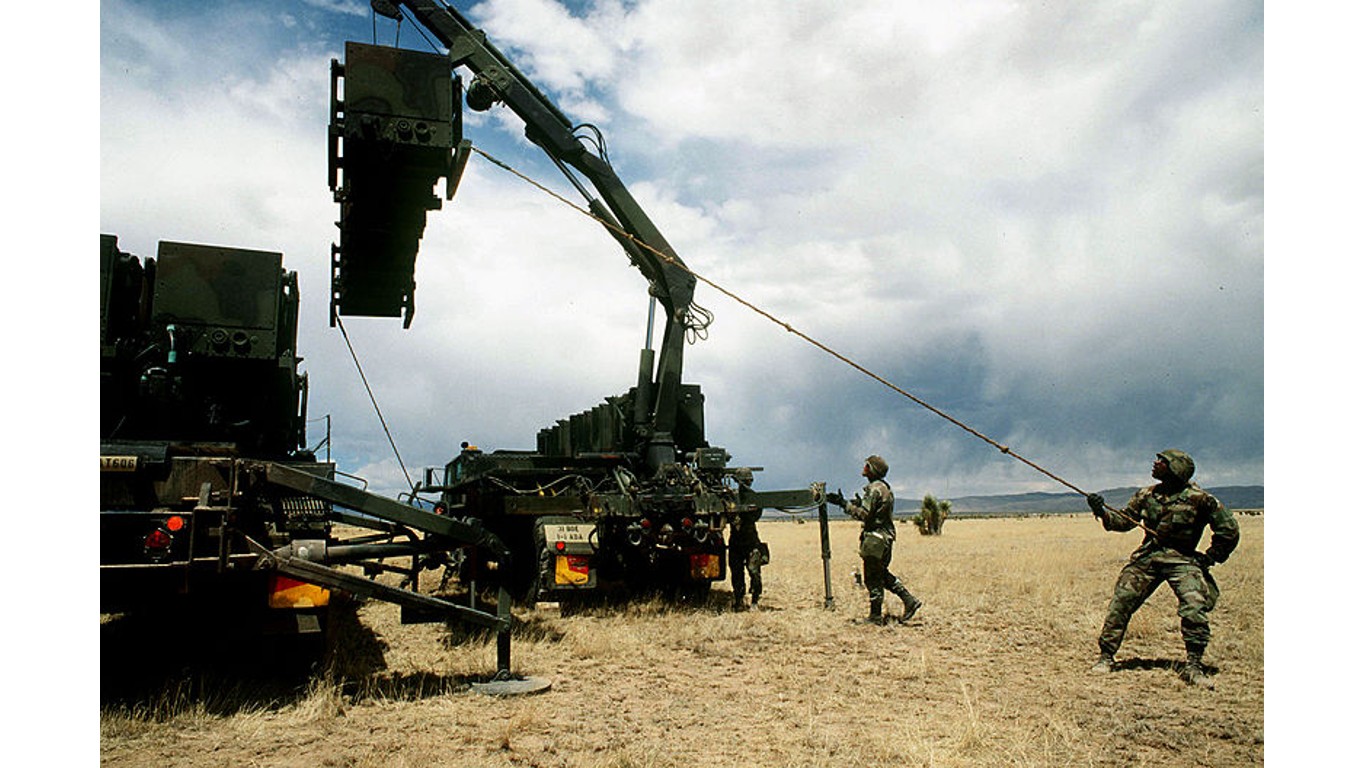
31. PATRIOT / PAC-3 PATRIOT Advanced Capability
> Requested budget for 2024: $1.2 billion
> Budget for 2023: $786.1 million
> Requested acquisitions, FY2024: None
> Acquisitions, FY2023: None
> Service branches: Army
> Primary contractor(s): Raytheon Integrated Defense Systems
Department of Defense: “Implements critical capability, readiness and sustainability modifications and continues software enhancement for improved combat identification, improved communications, interoperability, supportability, electronic warfare capabilities; and supports transition to the Integrated Air and Missile Defense architecture. LTAMDS will fund three sensors in FY 2024 to support the Pacific Deterrence initiative to provide an Early Operational Capability. FY 2024 funding will also fund two (2) sensors to support LTAMDS testing…”

30. PAC-3 / MSE PAC-3/Missile Segment Enhancement
> Requested budget for 2024: $1.2 billion
> Budget for 2023: $1.0 billion
> Requested acquisitions, FY2024: 230 units
> Acquisitions, FY2023: 252 units
> Service branches: Army
> Primary contractor(s): Lockheed Martin Missiles and Fire Control
Department of Defense: “Funds the production of 230 MSE missiles, Field Surveillance Program, PAC-3 Missile Support Center, Obsolescence, System Engineering/Program Management, and Government/Software Engineering.”
[in-text-ad]
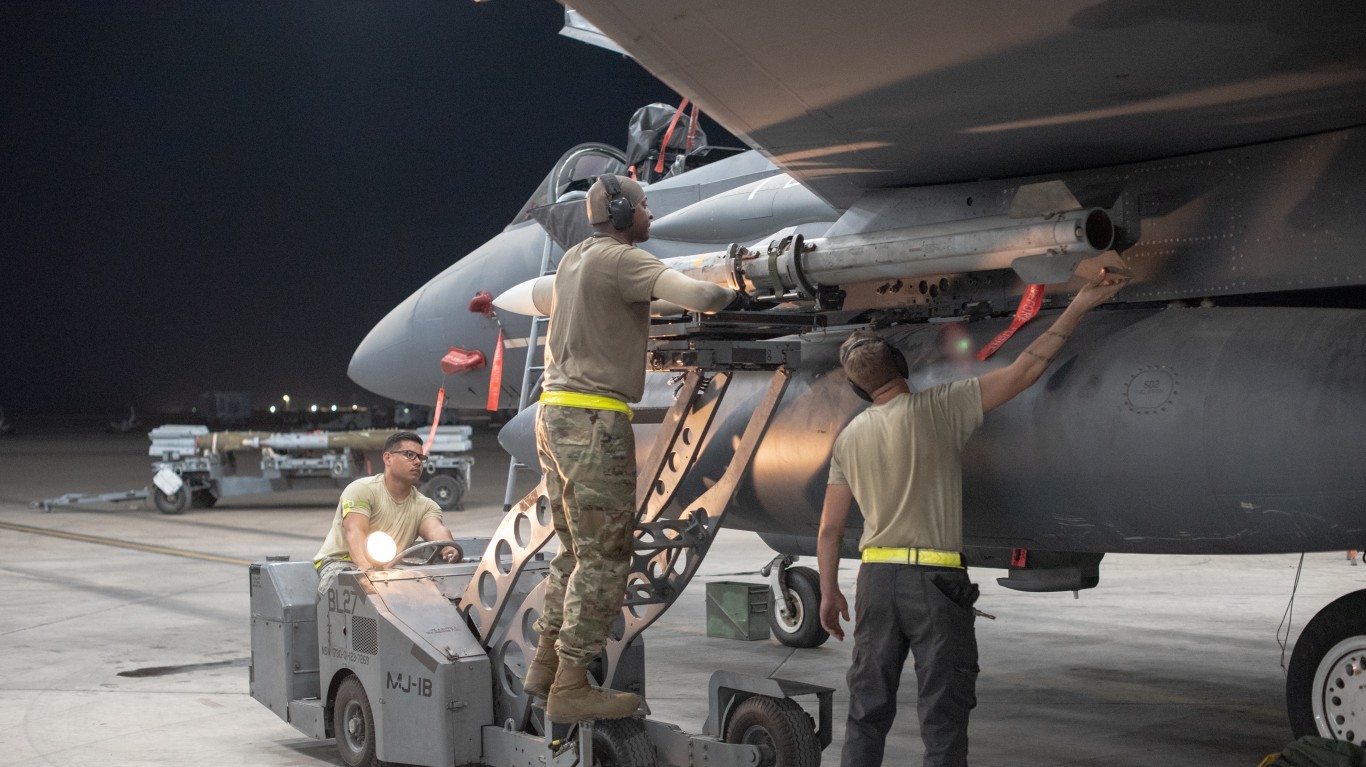
29. AMRAAM Advanced Medium Range Air-to-Air Missile
> Requested budget for 2024: $1.2 billion
> Budget for 2023: $739.6 million
> Requested acquisitions, FY2024: 831 units (457 for Air Force, 374 for Navy)
> Acquisitions, FY2023: 608 units (271 for Air Force, 337 for Navy)
> Service branches: Joint service
> Primary contractor(s): Raytheon Missile & Defense
Department of Defense: “Funds the first year of a Multiyear Procurement (MYP) contract under the Large Lot Procurement concept. Continues production of the AIM-120D and addresses component parts obsolescence as well as future warfighting improvements.”

28. CVN Refueling Complex Overhaul
> Requested budget for 2024: $1.2 billion
> Budget for 2023: $2.6 billion
> Requested acquisitions, FY2024: None
> Acquisitions, FY2023: None
> Service branches: Navy
> Primary contractor(s): The Boeing Company
Department of Defense: “Funds advance procurement of long lead items for the USS Harry S Truman (CVN 75) with the RCOH scheduled to being in FY 2025. The FY 2024 request also funds cost to complete for the USS John C. Stennis (CVN 74).”
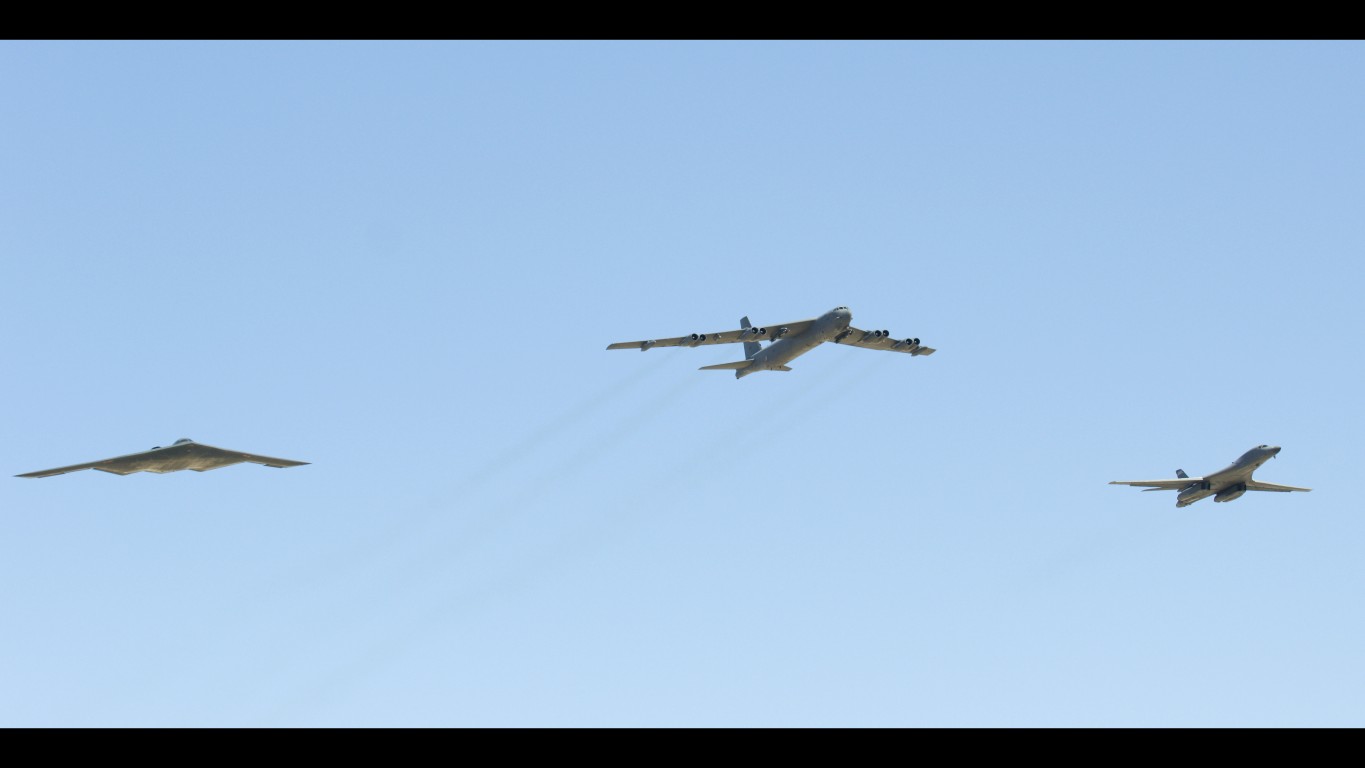
27. B-1, B-2, B-52 Bombers
> Requested budget for 2024: $1.3 billion
> Budget for 2023: $1.1 billion
> Requested acquisitions, FY2024: None
> Acquisitions, FY2023: None
> Service branches: Air force
> Primary contractor(s): Northrop Grumman Aerospace Systems, Boeing Defense
Department of Defense: “Continues upgrades to modernize legacy bombers including avionics, communications, radar, engine, and weapons efforts.”
[in-text-ad-2]
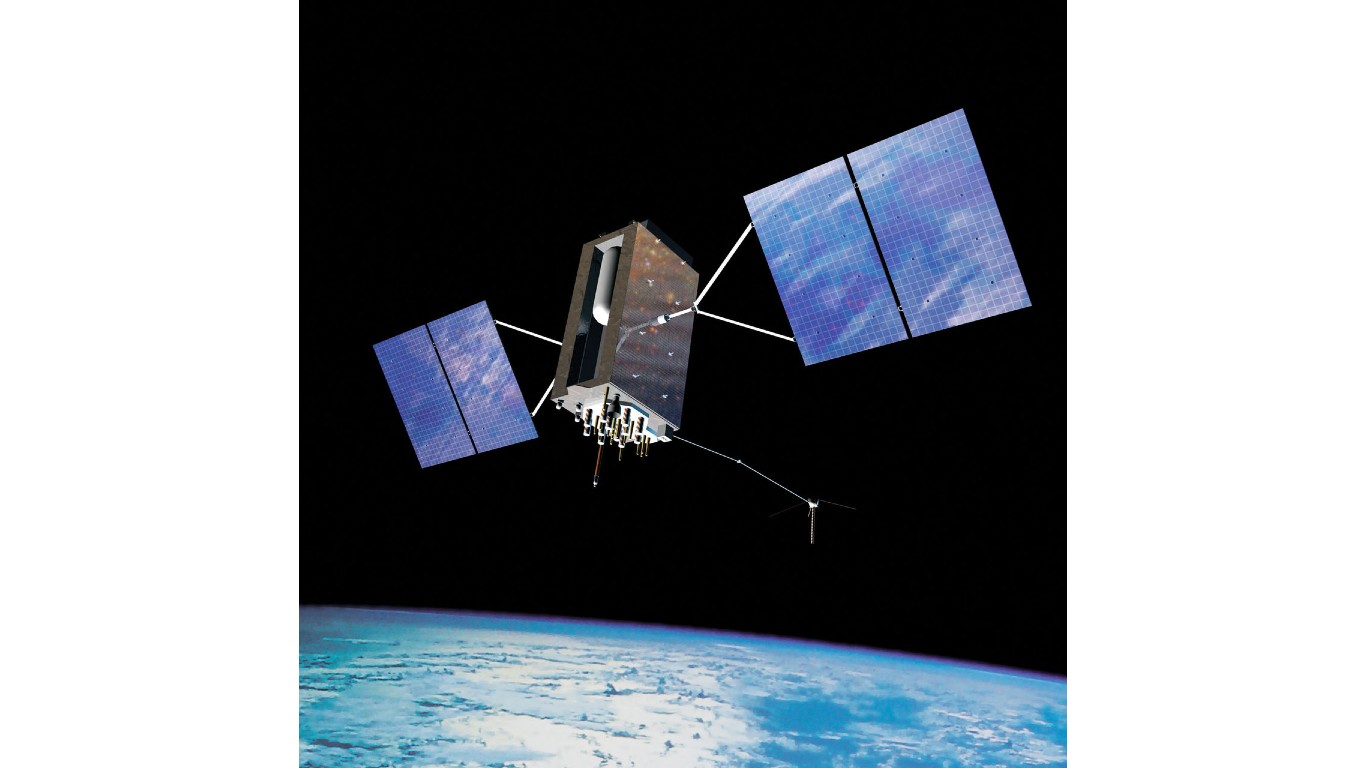
26. GPS III & Projects Global Positioning System Enterprise
> Requested budget for 2024: $1.3 billion
> Budget for 2023: $1.7 billion
> Requested acquisitions, FY2024: None
> Acquisitions, FY2023: 2
> Service branches: Space force
> Primary contractor(s): Raytheon Company, Lockheed Martin Corporation, BAE Systems, L3Harris, Raytheon Company
Department of Defense: “Funds independent, technical, systems engineering and integration support critical to managing SVs 07-10 storage, launch, and checkout activities. Funds continued development of the GPS IIIF SVs 11-20… Funds the GPS Program Office’s responsibility as the Prime Integrator (Enterprise Integration) to synchronize space, control, and user segment programs and to manage civil/military specifications and requirements.”
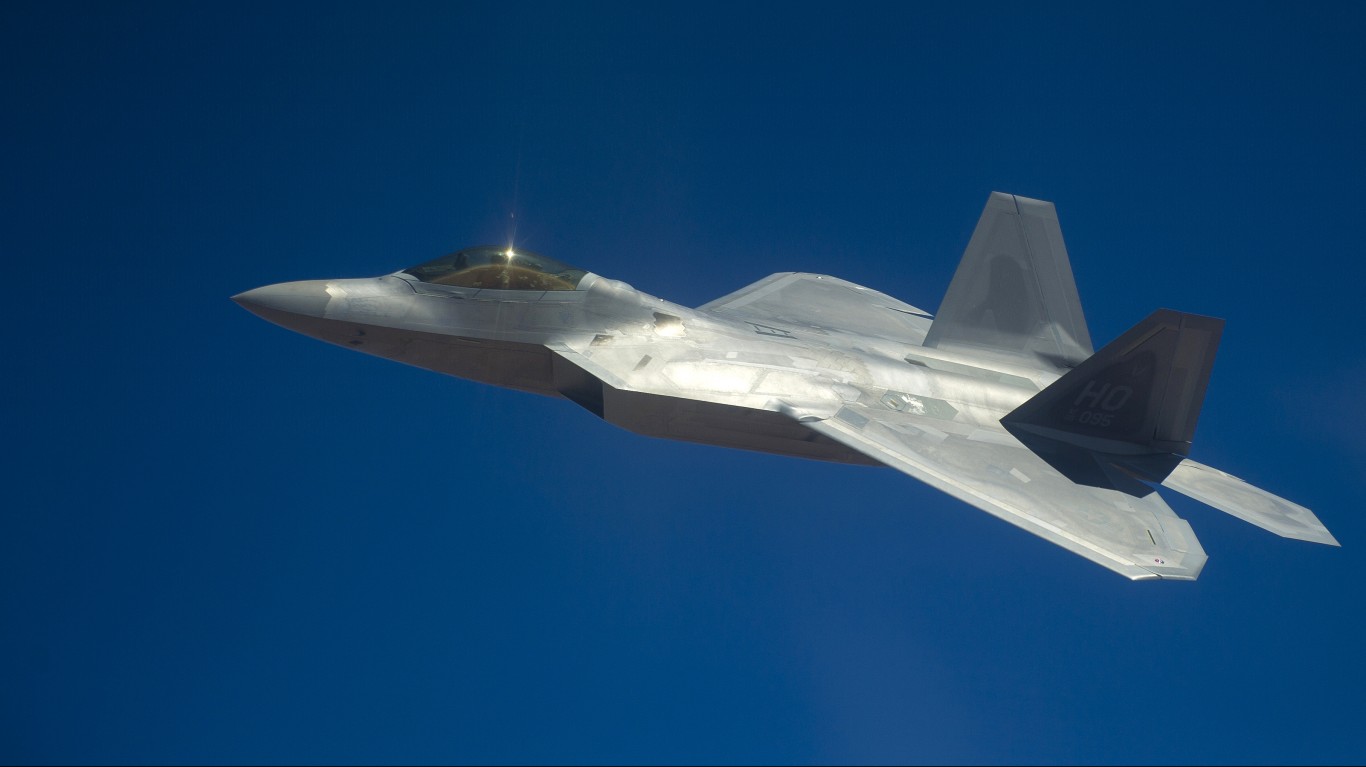
25. F-22 Raptor
> Requested budget for 2024: $1.5 billion
> Budget for 2023: $1.3 billion
> Requested acquisitions, FY2024: None
> Acquisitions, FY2023: None
> Service branches: Air force
> Primary contractor(s): Airframe: Lockheed Martin
Department of Defense: “Continues deliberate investments via the Raptor Agile Capability Release program to ensure F-22s are upgraded with state-of-the-art sensors, improved survivability, enhanced interoperability, and extended range and time on station. The FY 2024 program continues critical planned modernization for F-22 aircraft… that will enhance the F-22 Air Superiority and Global Strike capabilities in highly contested environments… the F-22 Rapid Prototyping/Rapid Fielding programs will continue to release upgraded communications systems, navigation systems, and critical sensor enhancement as well as provide initial procurement and fielding for low drag tanks/pylons capabilities to meet advanced threats expected in 2025 and beyond.”
[in-text-ad]
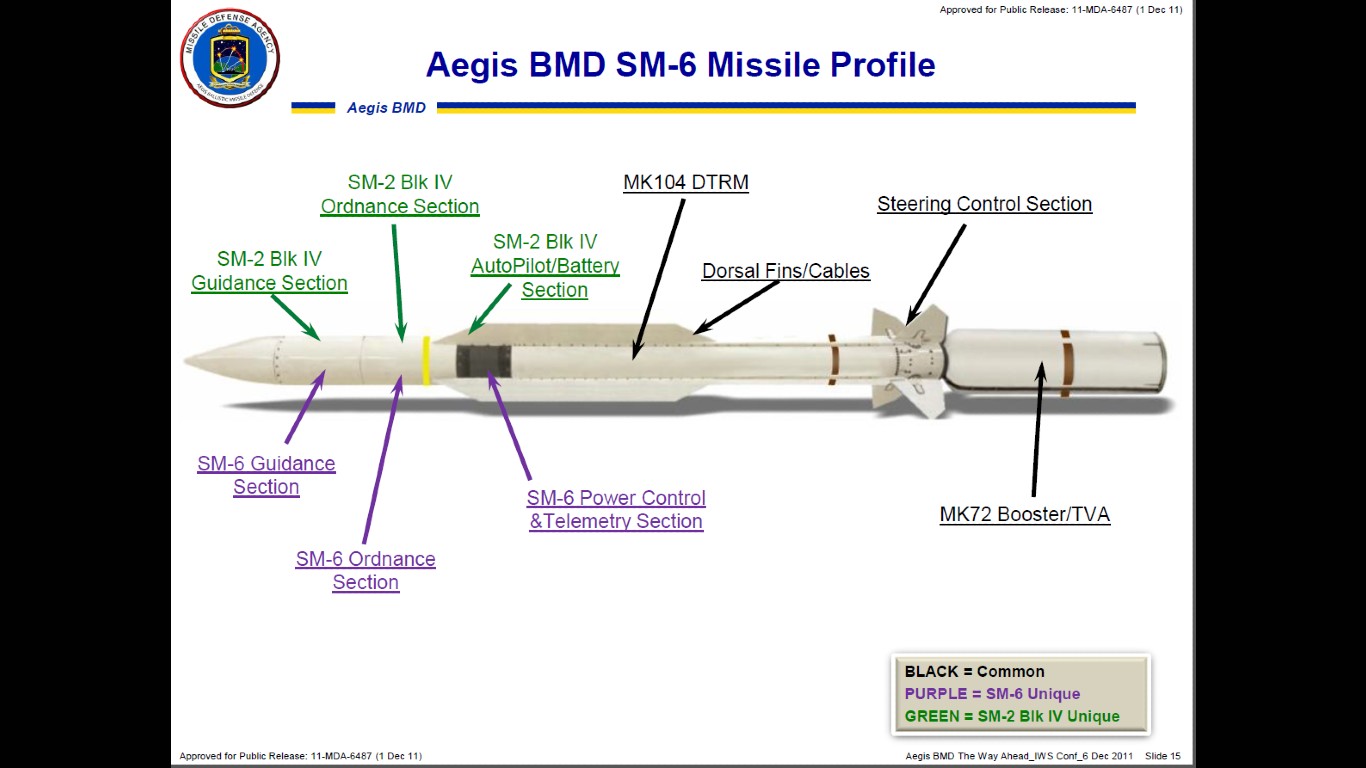
24. Standard Missile-6
> Requested budget for 2024: $1.6 billion
> Budget for 2023: $799.0 million
> Requested acquisitions, FY2024: 125 units
> Acquisitions, FY2023: 125 units
> Service branches: Navy
> Primary contractor(s): Raytheon Missiles & Defense
Department of Defense: “Continues production of the Block IA missile and begins production in FY 2024 of the Block IB variant. The factory will operate at the maximum production rate. RDT&E funding continues Aegis architecture and design for SM-6 Block IB extended range capability, the procurement of Block IB components including ground test and controlled test vehicle hardware, MK-29 Mod I canisters for the Block IB flight and safety qualification testing, and seven (7) fleet experimentation rounds.”
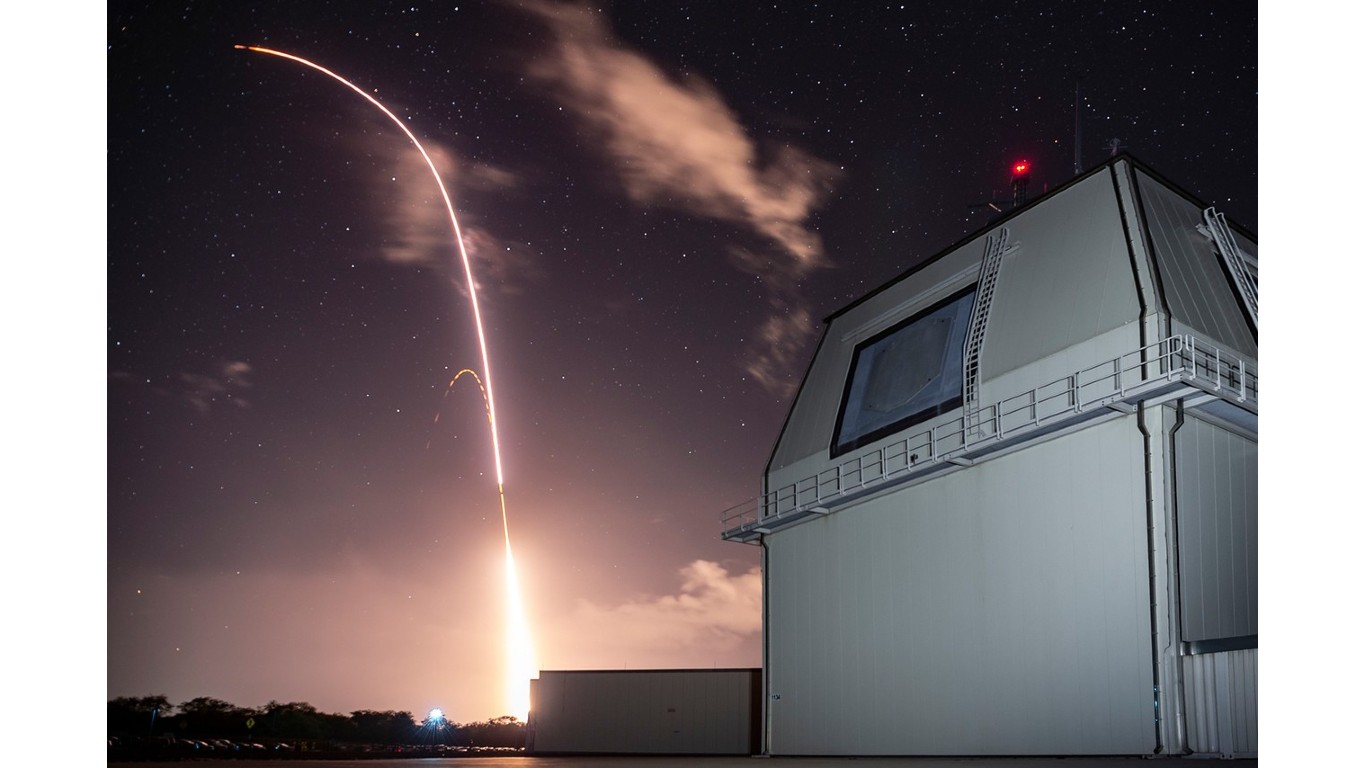
23. Aegis Sea-Based Weapons System
> Requested budget for 2024: $1.7 billion
> Budget for 2023: $1.9 billion
> Requested acquisitions, FY2024: 48 units (39 interceptors, 9 hardware+software installs)
> Acquisitions, FY2023: 77 units (71 interceptors, 6 hardware + software installs)
> Service branches: Joint service
> Primary contractor(s): Lockheed Martin Corporation
Department of Defense: “Procures 27 SM-3 Block IB’s and 12 SM-3 Block IIA’s… Funds capability upgrades for Aegis Baseline 5 (BMD 4.x) and Aegis Baseline 9 (BMD 5.x) Weapon Systems and the development of Aegis BL 10 (BMD 6). Procures 9 BMD 4.x/5.x shipsets. Continues technology maturation and prototyping support for the AN/SPY-1 Digital Receive Upgrades (DRU) to improve sensitivity, tracking performance, and resource utilization. Funds development of Aegis assets for the Defense of Guam. Funds Ground and Flight testing in support of the Integrated Master Test Plan requirements.”
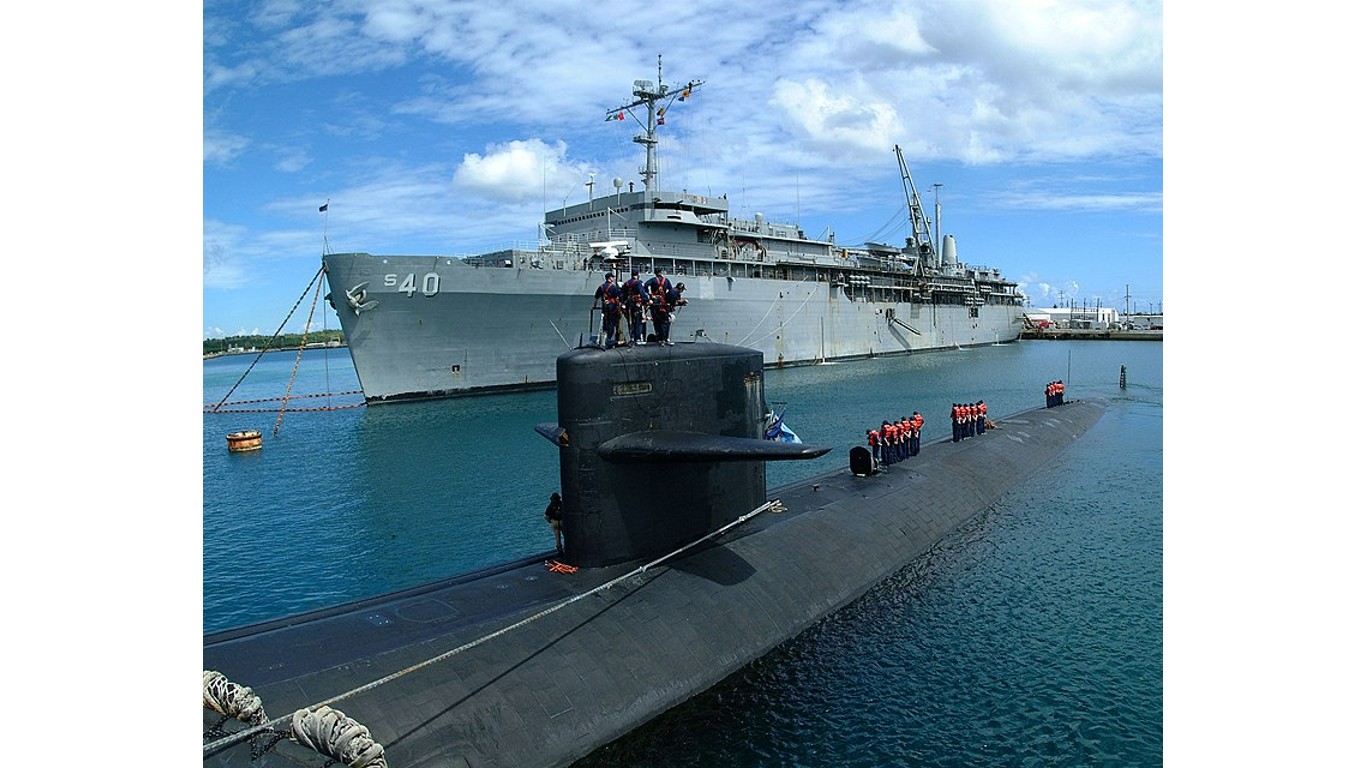
22. AS(X) Submarine Tender Replacement
> Requested budget for 2024: $1.7 billion
> Budget for 2023: $15.5 million
> Requested acquisitions, FY2024: 1 unit
> Acquisitions, FY2023: None
> Service branches: Navy
> Primary contractor(s): TBD
Department of Defense: “Funds construction of the lead AS(X) Submarine Tender Replacement.”
[in-text-ad-2]

21. JASSM Joint Air-to-Surface Standoff Missile
> Requested budget for 2024: $1.8 billion
> Budget for 2023: $902.2 million
> Requested acquisitions, FY2024: 550 units
> Acquisitions, FY2023: 550 units
> Service branches: Joint service
> Primary contractor(s): Lockheed Martin Missiles and Fire Control
Department of Defense: “Funds the first year of a Multiyear Procurement (MYP) contract under the Large Lot Procurement concept. Continues production of the AGM-158B and development efforts on the AGM-158D.”
20. F/A-18 Super Hornet
> Requested budget for 2024: $1.8 billion
> Budget for 2023: $2.1 billion
> Requested acquisitions, FY2024: None
> Acquisitions, FY2023: 8 units
> Service branches: Navy / marine corps
> Primary contractor(s): Boeing, General Electric Company
Department of Defense: “Begins Production Line Shutdown as FY 2023 is the last year of the E/F model multiyear procurement contract (FY 2021 – FY 2023). Continues to fund spares, repair parts, and the Service Life Extension Program to maintain sufficient aircraft inventory to meet fleet operational requirements through FY 2046. Development and integration of critical aircraft systems, like the Infrared Search and Track (IRST) pod, continues to ensure the F/A-18 E/F can meet advanced threats expected in 2025 and beyond.”
[in-text-ad]
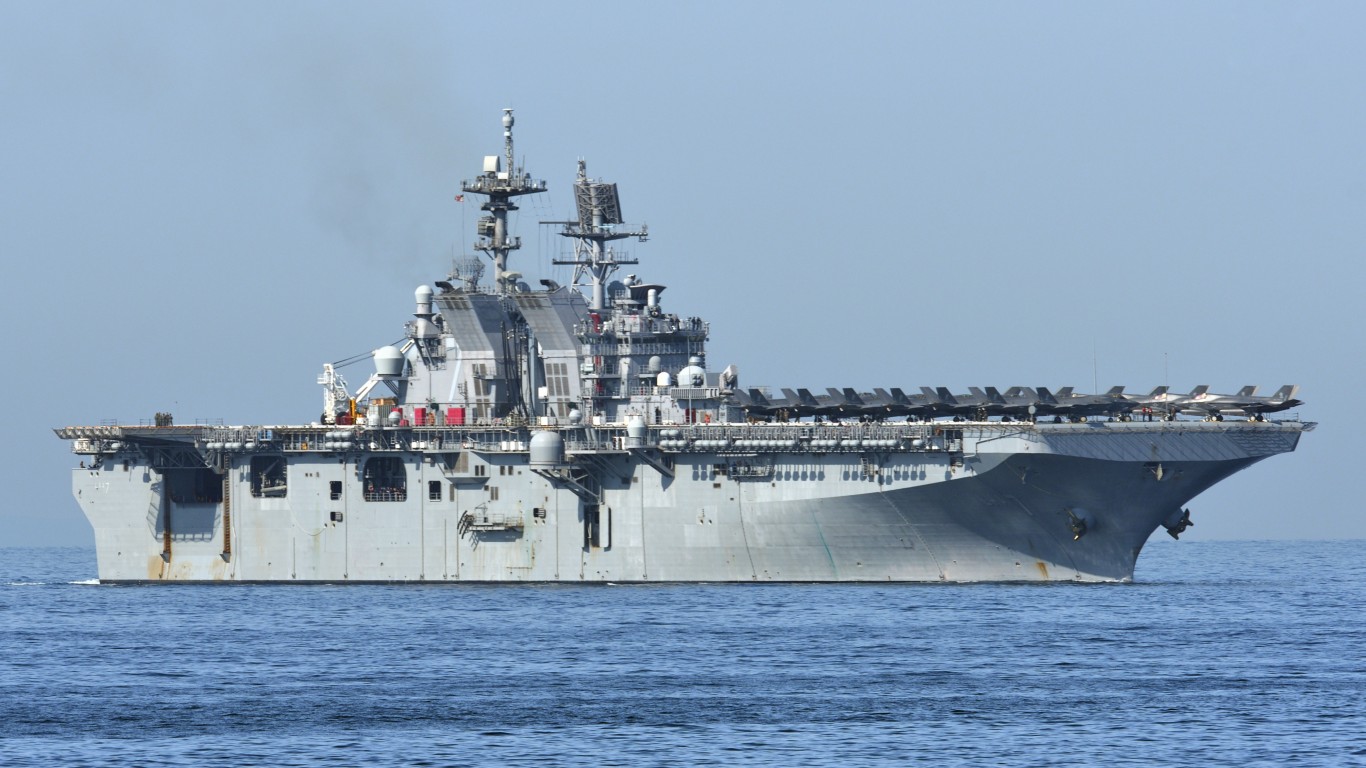
19. LHA America Class Amphibious Assault Ship
> Requested budget for 2024: $1.9 billion
> Budget for 2023: $1.4 billion
> Requested acquisitions, FY2024: None
> Acquisitions, FY2023: 1 unit
> Service branches: Navy
> Primary contractor(s): Huntington Ingalls Industries
Department of Defense: “Continues funding construction of LHA-9, the second Flight I LHA Replacement, and completion and outfitting costs.”
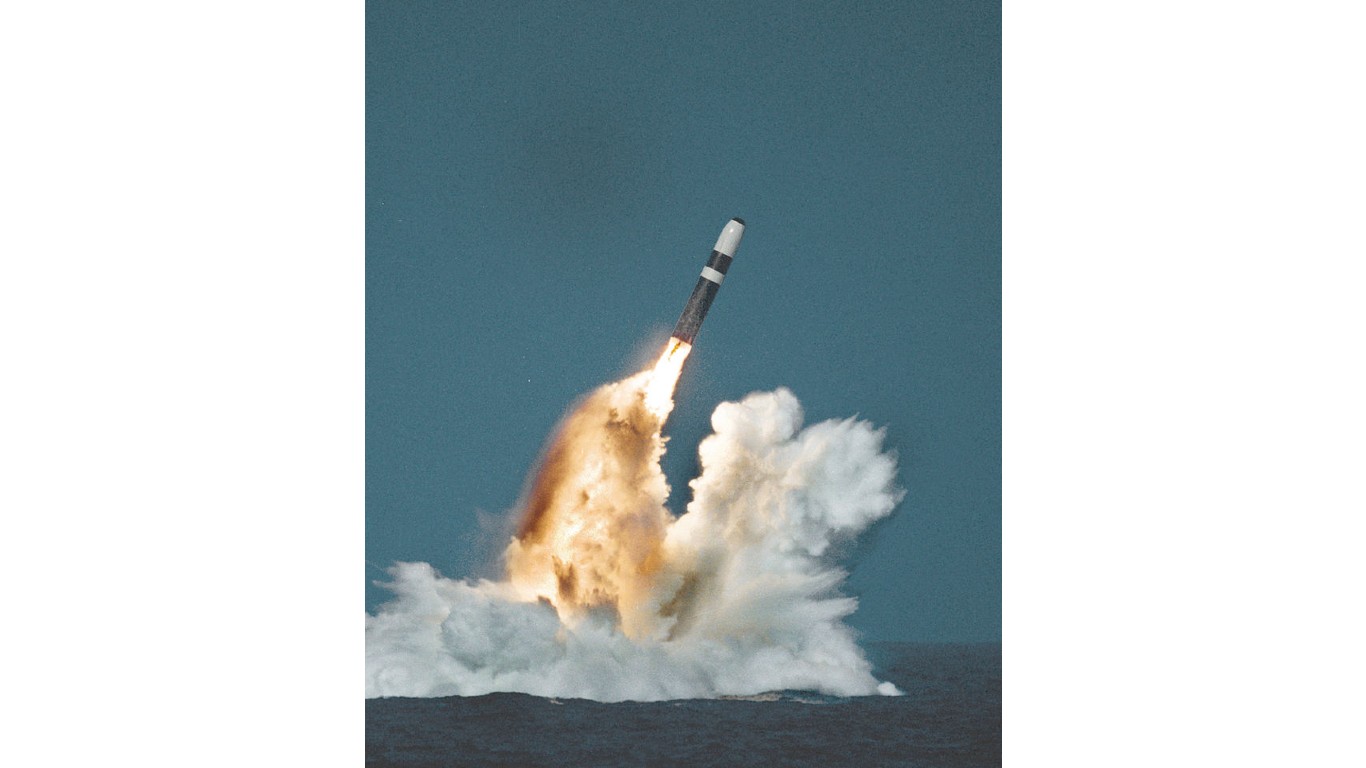
18. Trident II Trident II Ballistic Missile Modifications
> Requested budget for 2024: $1.9 billion
> Budget for 2023: $1.7 billion
> Requested acquisitions, FY2024: None
> Acquisitions, FY2023: None
> Service branches: Navy
> Primary contractor(s): Lockheed Martin Corporation
Department of Defense: “Supports the production of the redesigned missile which will be deployed on the COLUMBIA-class Fleet Ballistic Missile Submarine. Funds support procurement of Trident II D5LE warhead components, the Mk4B Shape Stable Nose Tip (SSNT), and replacement of D5 legacy tooling and test support equipment. Development efforts of the D5LE2 include system studies and architecture development, W93/Mk7 warhead feasibility study and design options, as well as Submarine Launched Ballistic Missile (SLBM) and strategic guidance technologies in order to deliver a System Requirements Review in FY 2025.”
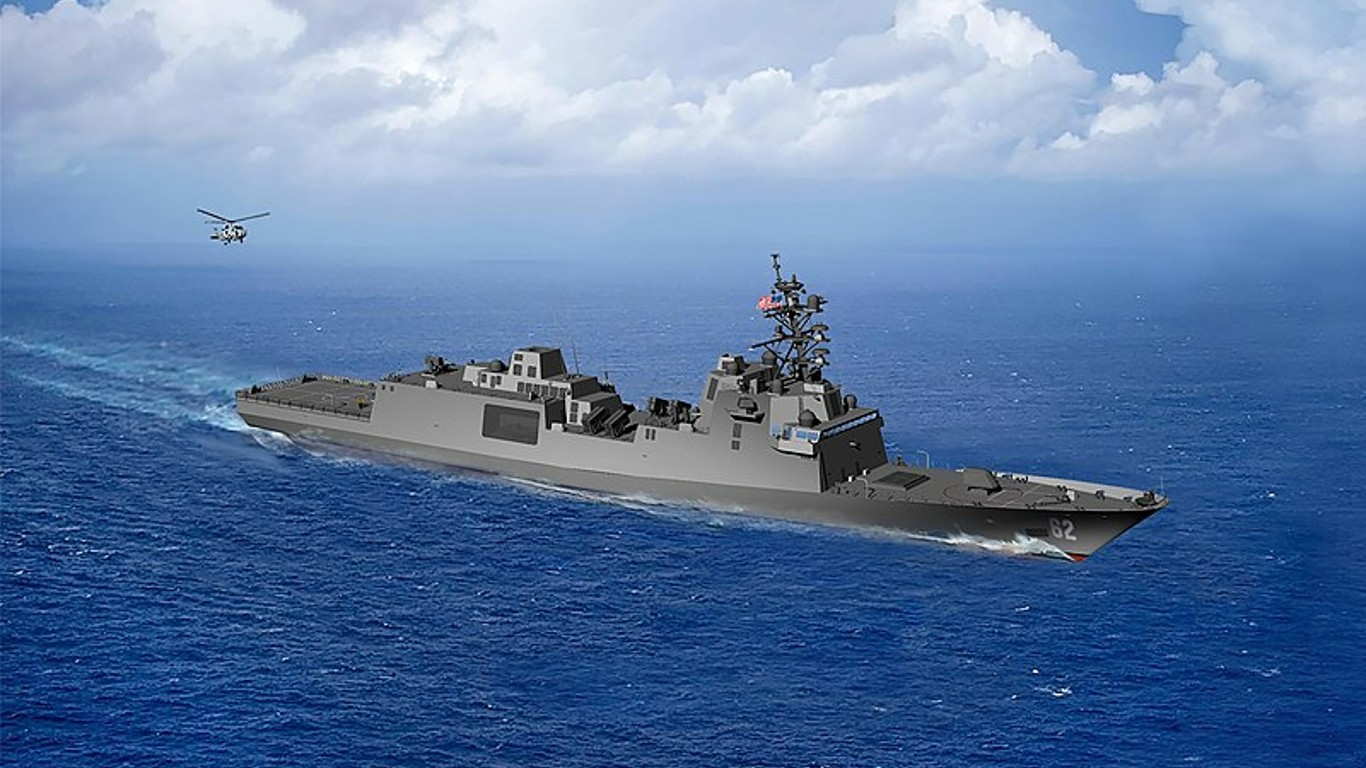
17. FFG(X) Constellation Class Guided Missile Frigate
> Requested budget for 2024: $2.3 billion
> Budget for 2023: $1.2 billion
> Requested acquisitions, FY2024: 2 units
> Acquisitions, FY2023: 1 unit
> Service branches: Navy
> Primary contractor(s): Fincantieri Marinette Marine
Department of Defense: “Continues funding construction of the Constellation class, advance procurement for future ships, and continues research and development of ship systems and design.”
[in-text-ad-2]
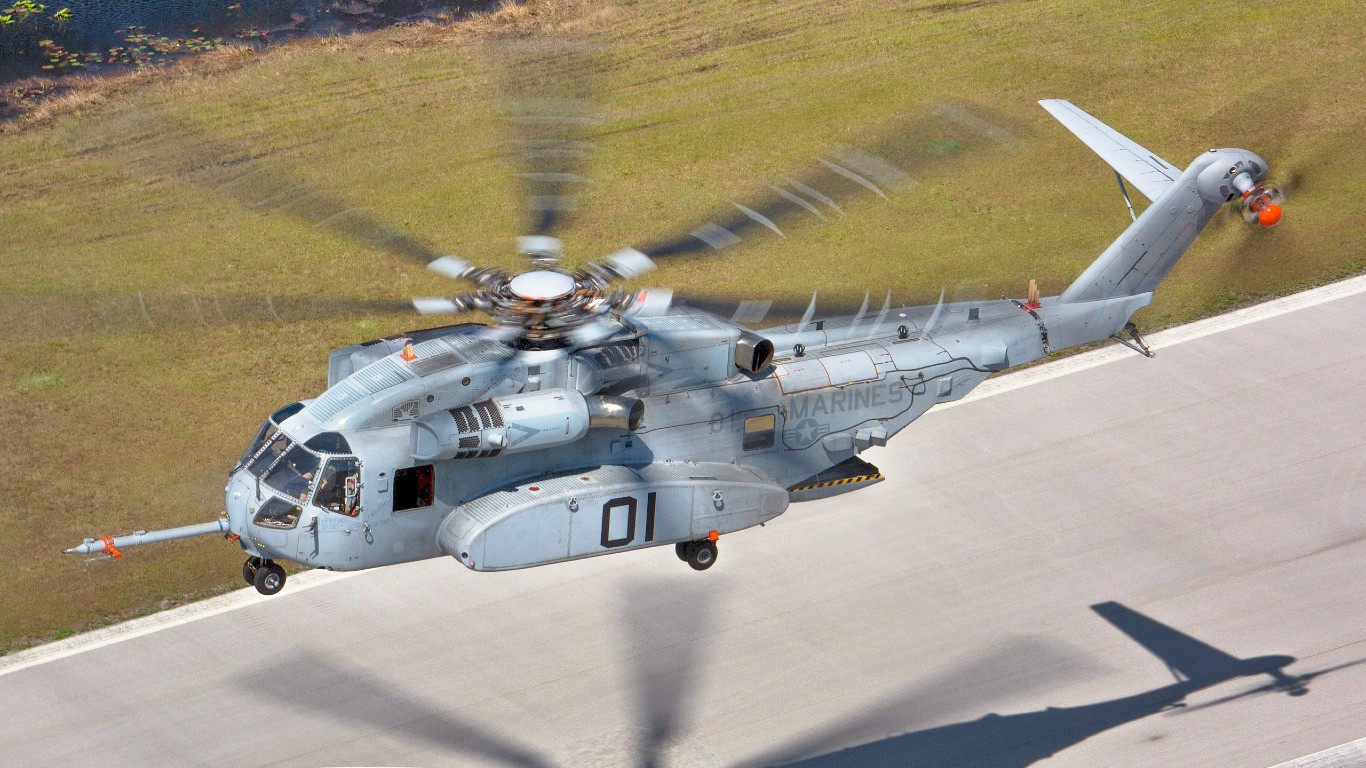
16. CH-53K Heavy Lift Replacement Helicopter
> Requested budget for 2024: $2.4 billion
> Budget for 2023: $2.5 billion
> Requested acquisitions, FY2024: 15 units
> Acquisitions, FY2023: 12 units
> Service branches: Navy / marine corps
> Primary contractor(s): Sikorsky Aircraft Corporation, General Electric Company
Department of Defense: “Funds support continued software development and the correction of deficiencies discovered during Initial Operational Test and Evaluation resulting in the establishment of the final deployable configuration. The program also funds the procurement of 15 aircraft.”
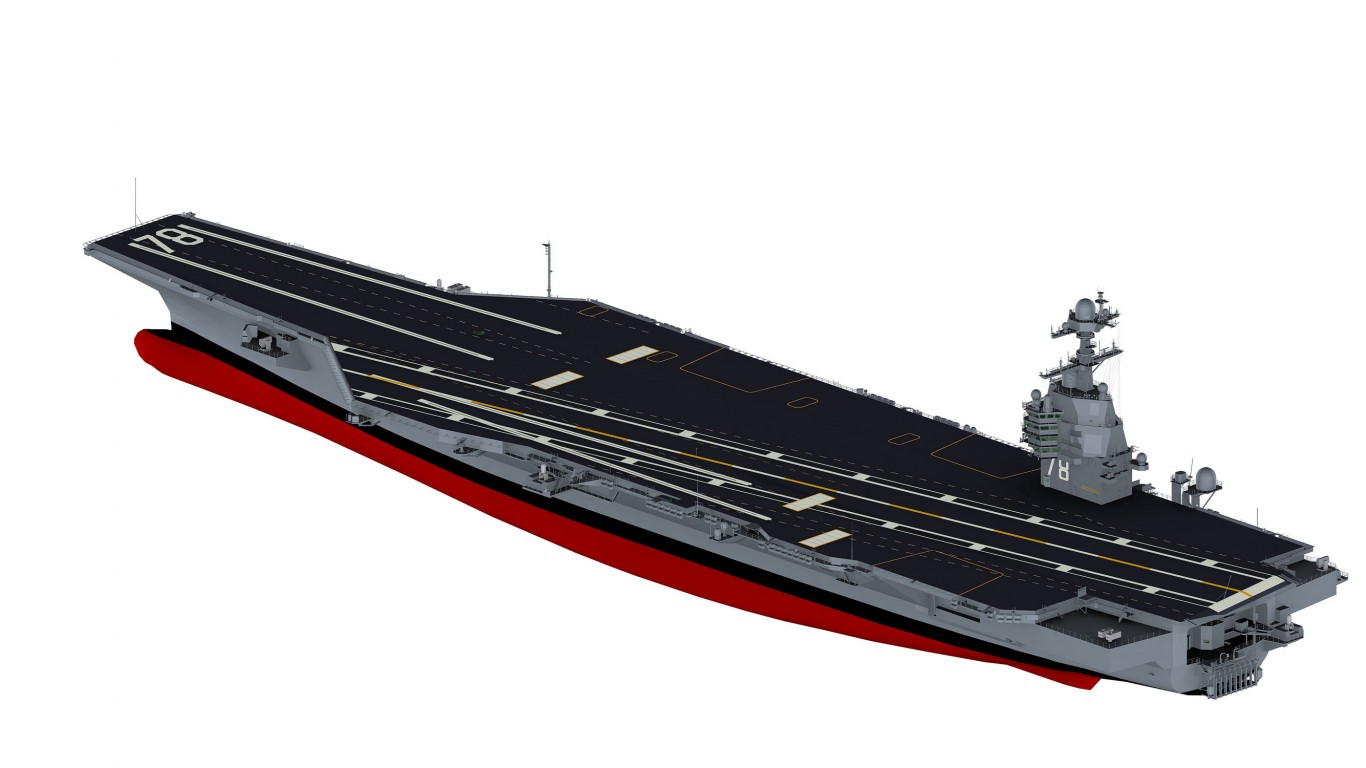
15. CVN 78 Gerald R. Ford Class Nuclear Aircraft Carrier
> Requested budget for 2024: $2.7 billion
> Budget for 2023: $3.7 billion
> Requested acquisitions, FY2024: None
> Acquisitions, FY2023: None
> Service branches: Navy
> Primary contractor(s): Huntington Ingalls Industries
Department of Defense: “Funds continued construction for three carriers USS John F. Kennedy (CVN 79), USS Enterprise (CVN 80) and USS Doris Miller (CVN 81). CVN 80 and CVN 81 comprise a two-carrier procurement contract, awarded in FY 2019, which is expected to yield approximately $4.0 billion in savings. Additional funding includes outfitting, training equipment, and continued development of ship systems.”
[in-text-ad]
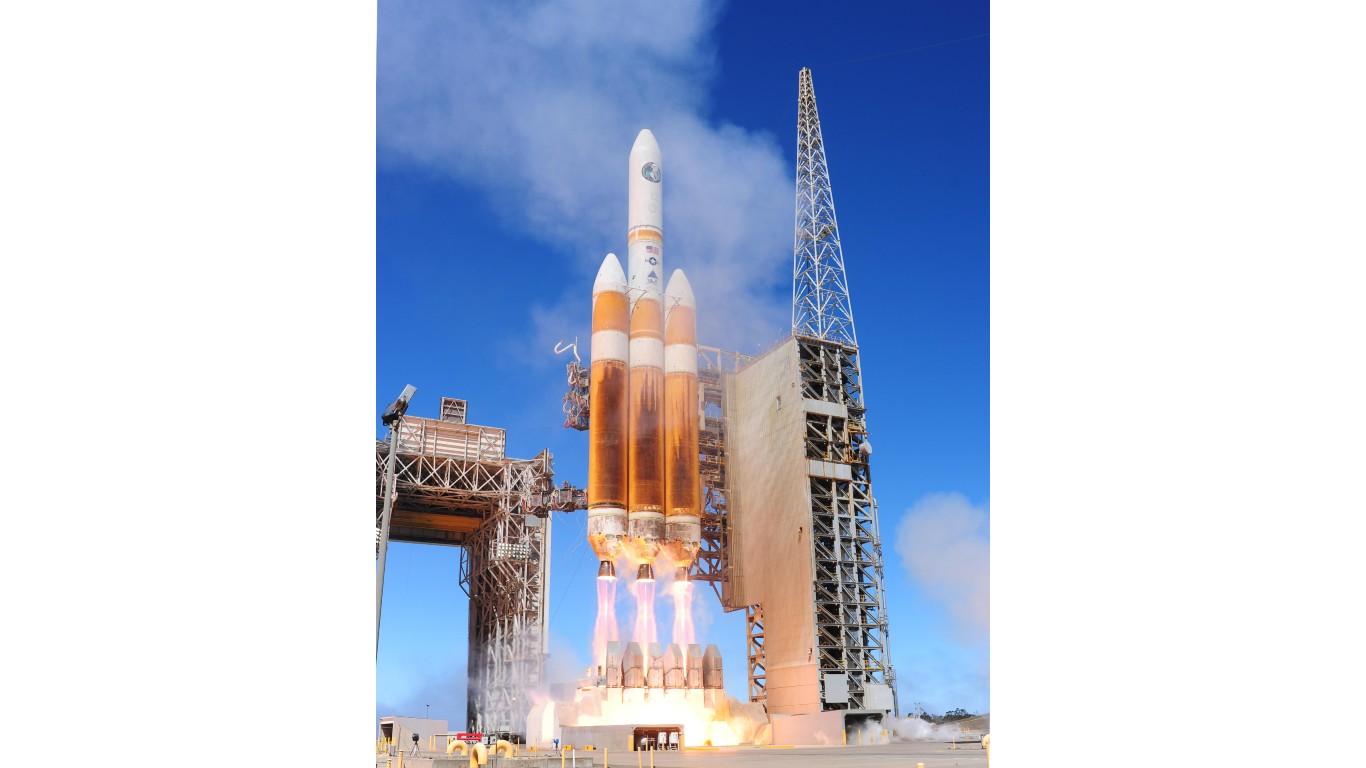
14. NSSL & RSLP Launch Enterprise
> Requested budget for 2024: $3.0 billion
> Budget for 2023: $2.2 billion
> Requested acquisitions, FY2024: 15 units
> Acquisitions, FY2023: 10 units
> Service branches: Space force
> Primary contractor(s): SpaceX. United Launch Alliance (ULA), Northrop Grumman, Rocket Lab, USA, VOX Space
Department of Defense: “Procures ten Space Force Launch Services (LS) using the competitively awarded NSSL Phase 2 contract and five Space Development Agency launch services. Launches are usually ordered 24 months prior to the planned mission. Funds Launch Service Support (LSS) efforts, which are non-discrete tasks necessary to support vital national security space launches without driving undue costs to commercial launch services.”
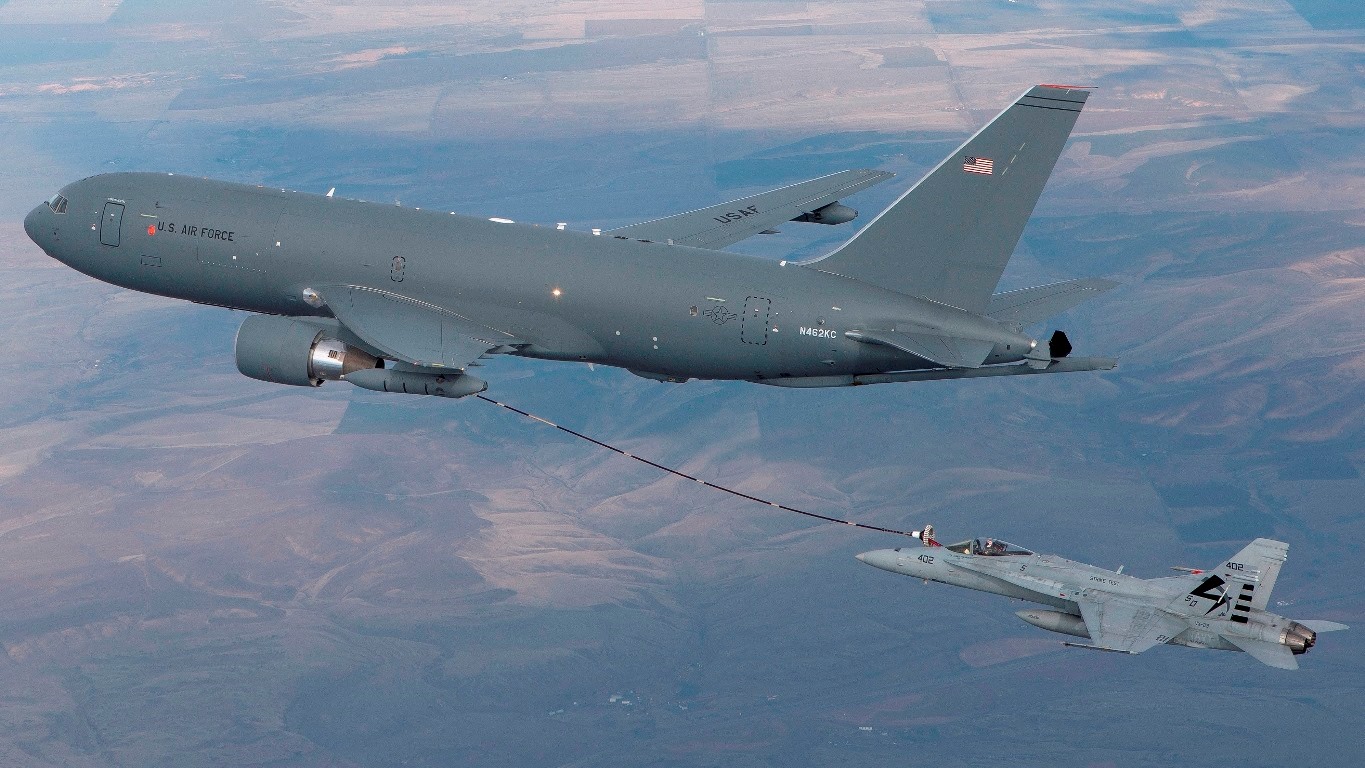
13. KC-46A Tanker
> Requested budget for 2024: $3.0 billion
> Budget for 2023: $2.6 billion
> Requested acquisitions, FY2024: 15 units
> Acquisitions, FY2023: 15 units
> Service branches: Air force
> Primary contractor(s): The Boeing Company
Department of Defense: “Procures 15 aircraft and continues the Air Force’s development efforts of a militarized variant of the Boeing 767-2C aircraft to include integration of military capabilities into four development aircraft and the associated developmental and operational testing. Supports development of technical manuals, training systems, and a collection of simulator and maintenance data.”
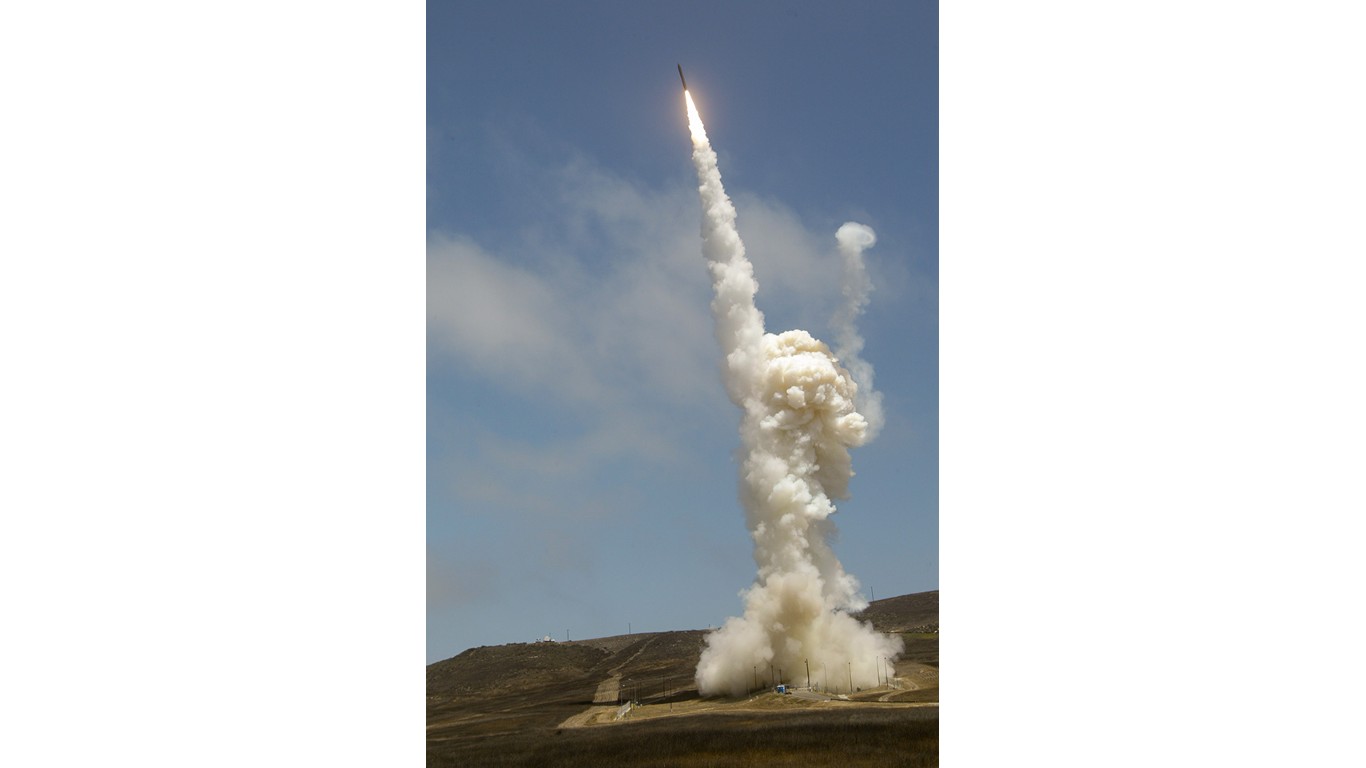
12. GMD Ground-based Midcourse Defense
> Requested budget for 2024: $3.1 billion
> Budget for 2023: $2.6 billion
> Requested acquisitions, FY2024: None
> Acquisitions, FY2023: None
> Service branches: Joint service
> Primary contractor(s): Boeing Defense and Space
Department of Defense: “Strengthens Homeland Missile Defense. Continues to develop a Next Generation Interceptor. Continues the design and development activities for two competitive interceptor development contracts. Next Generation Interceptor funding provides for the initial requirements analysis, design, development, prototyping, integration and relevant environment testing to mature the booster, payload, sensor, and design-specific critical technologies and technology elements. Upgrades and consolidates ground testing infrastructure and facilities. Upgrades and replaces ground system infrastructure fire control/kill vehicle software to improve the reliability and cybersecurity resiliency of the GMD weapon system. Funds Ground, Cyber and Flight testing to support the Integrated Master Test Plan.”
[in-text-ad-2]
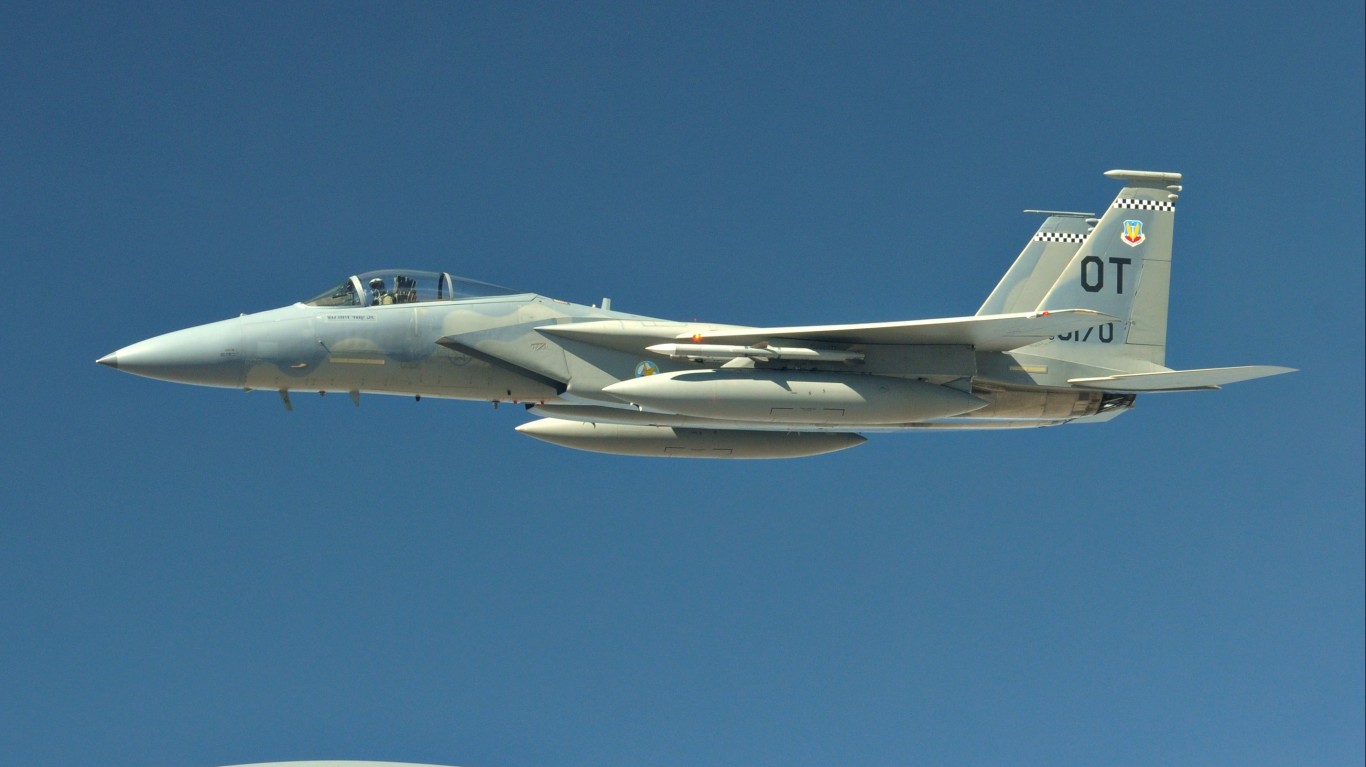
11. F-15 Eagle
> Requested budget for 2024: $3.4 billion
> Budget for 2023: $3.4 billion
> Requested acquisitions, FY2024: 24 units
> Acquisitions, FY2023: 24 units
> Service branches: Air force
> Primary contractor(s): Boeing
Department of Defense: “Continues procurement of the F-15EX aircraft and funds weapon system requirements needed for operational conversion from F-15C/D to F-15EX; also initiates funding for F-15EX conformal fuel tanks. Continues engineering and manufacturing development efforts for the Eagle Passive/Active Warning Survivability System to improve F-15E/EX survivability by enhancing the ability to detect, deny, or defeat air and ground threats. Continues F-15E modernization investment, focusing development efforts on the Operational Flight Program and Resilient Embedded GPS-INS. Procurement funding continues modification and support investments in Advanced Display Core Processor II, Multifunctional Information Distribution System – Joint Tactical Radio System, and Mobile User Objective System / Second Generation Anti-Jam Tactical UHF Radio for NATO.”

10. Cyberspace Cyberspace Activities
> Requested budget for 2024: $4.1 billion
> Budget for 2023: $3.5 billion
> Requested acquisitions, FY2024: None
> Acquisitions, FY2023: None
> Service branches: Joint service
> Primary contractor(s): Various
Department of Defense: “Continues to accelerate multiple innovative lines of effort across the Department to support the DoD Cyber Strategy and facilitate information advantage throughout the spectrum of competition, crisis, and conflict. The resulting capabilities enhance integrated deterrence by enabling power projection in and through cyberspace, increasing our adversaries’ cyberspace operations cost and reducing their likelihood of success. The FY 2024 program continues investments in cybersecurity, cyberspace operations (including the cyber mission force), and cyber research and development.”
[in-text-ad]
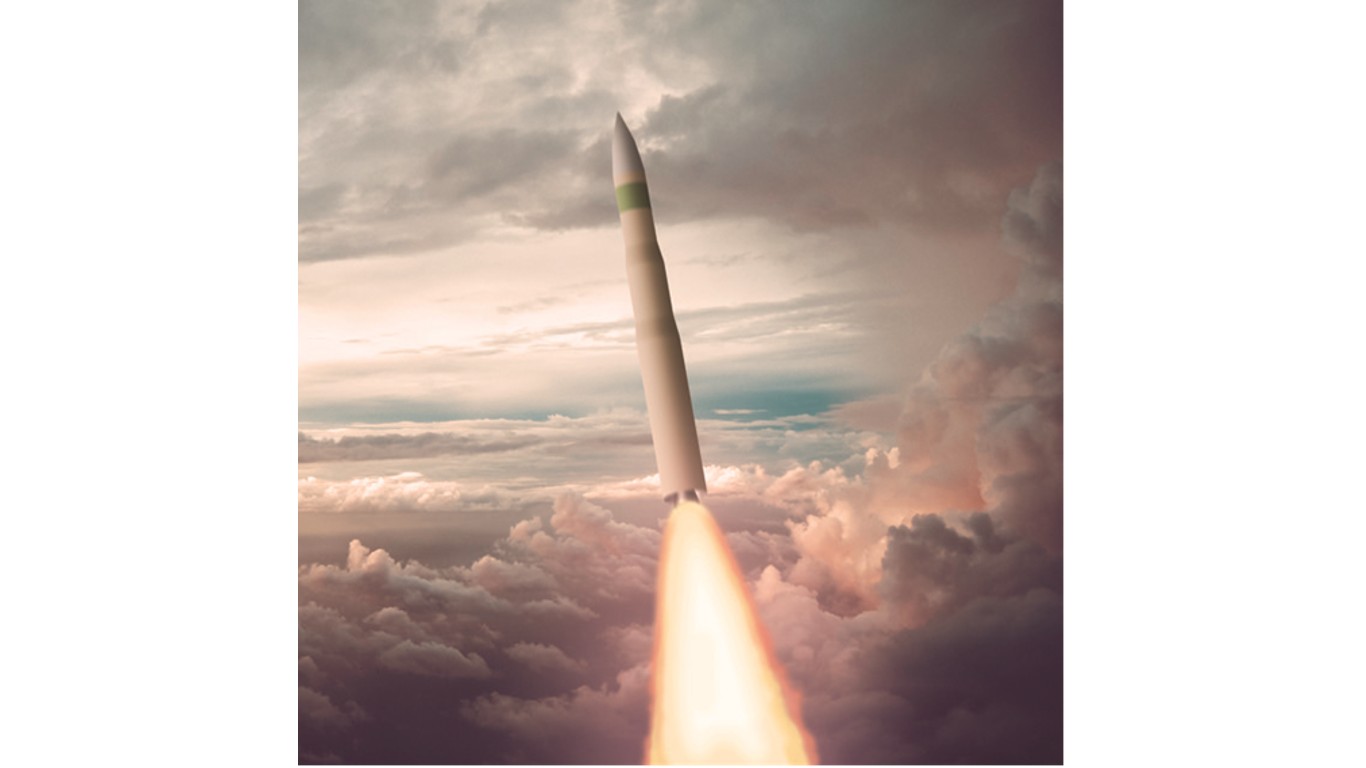
9. LGM-35A Sentinel
> Requested budget for 2024: $4.3 billion
> Budget for 2023: $3.6 billion
> Requested acquisitions, FY2024: 544 units
> Acquisitions, FY2023: None
> Service branches: Air force
> Primary contractor(s): Northrop Grumman Corporation
Department of Defense: “Funds activities in support of EMD to include: systems engineering activities, information technology, data management, testing, and analytical capabilities to deliver a flexible, integrated weapon system critical design. The program will start long-lead procurement for Inertial Measurement Unit Electronics, Missile Guidance Computer Electronics, Air Vehicle Booster and Post Boost Propulsion System, and Weapon System Structures (e.g., launch facilities/centers).”

8. SATCOM Projects Satellite Communications (SATCOM) Projects
> Requested budget for 2024: $4.7 billion
> Budget for 2023: $3.6 billion
> Requested acquisitions, FY2024: None
> Acquisitions, FY2023: None
> Service branches: Space force
> Primary contractor(s): Boeing Satellite Systems, Northrop Grumman, General Dynamics, Raytheon
Department of Defense: “Funds continue selected SATCOM development activities. Initiates PTS prototype payload launch vehicle integration and PTS Engineering and Manufacturing Development (EMD) phase for the new purpose-built high-throughput anti-jam satellite system.”
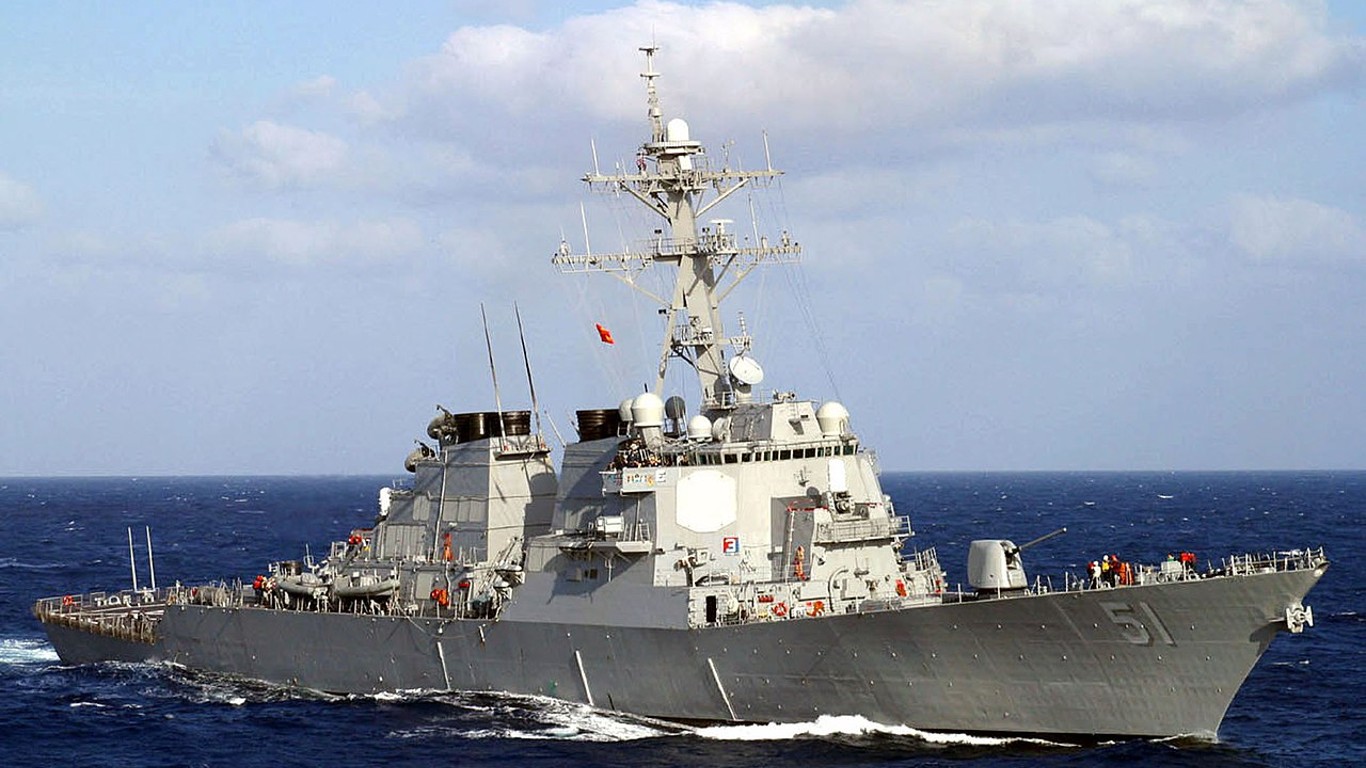
7. DDG 51 Arleigh Burke Class Destroyer
> Requested budget for 2024: $4.8 billion
> Budget for 2023: $4.2 billion
> Requested acquisitions, FY2024: 2 units
> Acquisitions, FY2023: 3 units
> Service branches: Navy
> Primary contractor(s): General Dynamics Corporation. Huntington Ingalls Industries
Department of Defense: “Funds two Flight III DDG 51 class destroyers in the second year of the FY 2023-FY 2027 multi-year procurement contract for up to 10 ships, … funding for the FY 2025-FY 2027 ships, outfitting costs, completion costs and continued development of ship systems. Starting in FY 2021, Bridge System Upgrades are incorporated for improved navigation capability.”
[in-text-ad-2]

6. AMMO Ammunition
> Requested budget for 2024: $5.0 billion
> Budget for 2023: $5.8 billion
> Requested acquisitions, FY2024: None
> Acquisitions, FY2023: None
> Service branches: Joint service
> Primary contractor(s): GD-OTS, AMTEC, Raytheon, BAE Systems
Department of Defense: “Procures various ammunition cartridges for use by the Army, Navy, Marine Corps, and Air Force to fulfill combat and training mission requirements.”
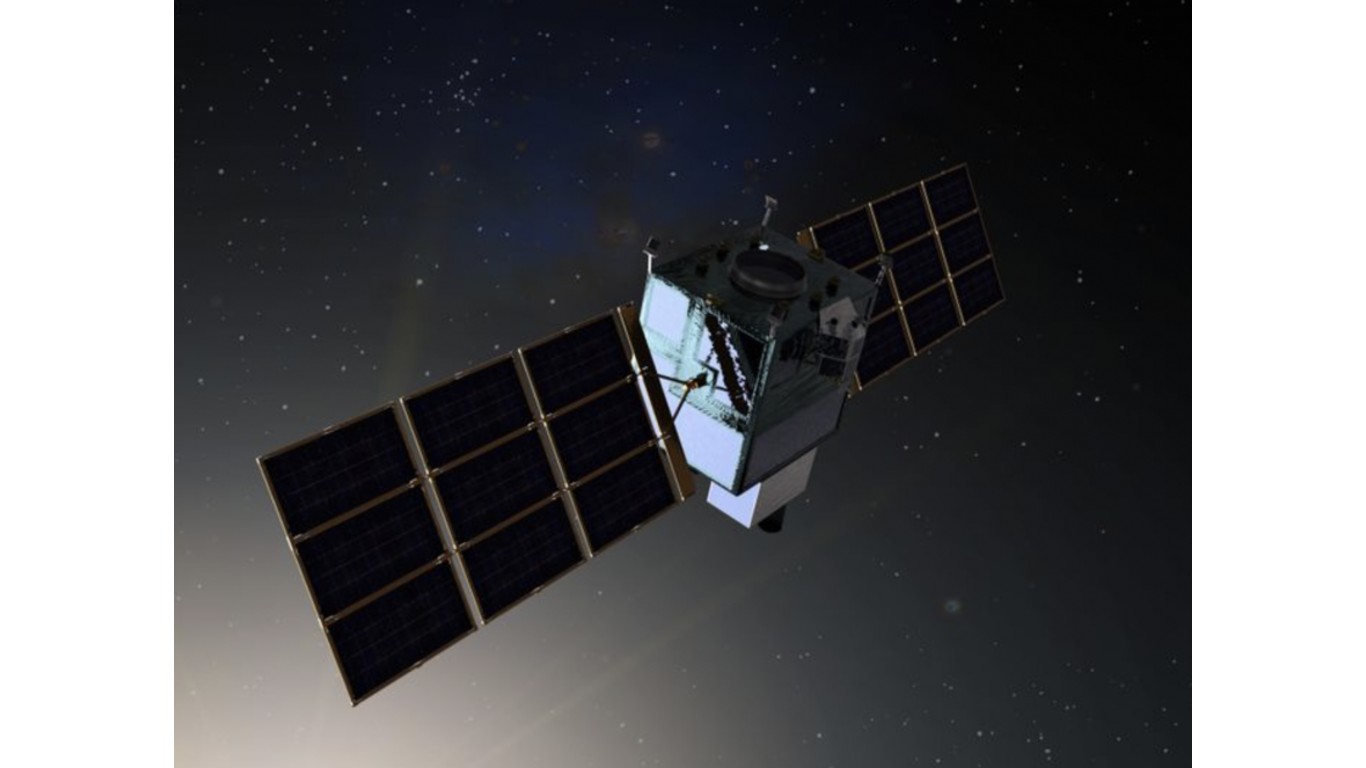
5. OPIR Space Based Missile Warning Systems
> Requested budget for 2024: $5.0 billion
> Budget for 2023: $4.7 billion
> Requested acquisitions, FY2024: None
> Acquisitions, FY2023: None
> Service branches: Space force
> Primary contractor(s): Lockheed Martin, Northrop Grumman, Raytheon
Department of Defense: “Funds continue development of Next-Gen OPIR satellites and the FORGE ground system development. Also funds development of Resilient MW/MT constellations in LEO and MEO; launch of LEO constellation begins in FY 2025.”
[in-text-ad]
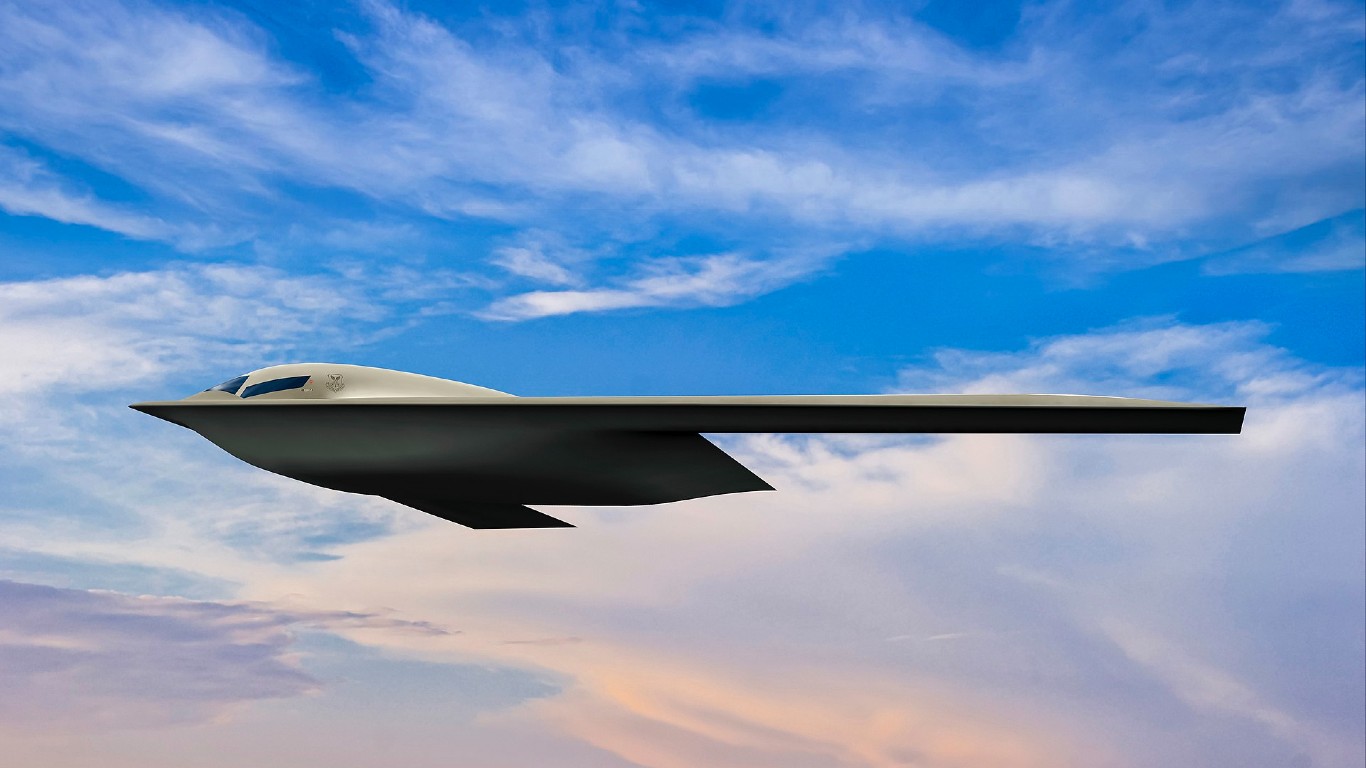
4. B-21 Raider
> Requested budget for 2024: $5.3 billion
> Budget for 2023: $4.8 billion
> Requested acquisitions, FY2024: None
> Acquisitions, FY2023: None
> Service branches: Air force
> Primary contractor(s): Northrop Grumman Corporation
Department of Defense: “Continues Engineering and Manufacturing Development of the B-21. Procurement funds will support the program’s transition to low rate initial production, which includes long lead parts. Additional details are classified.”
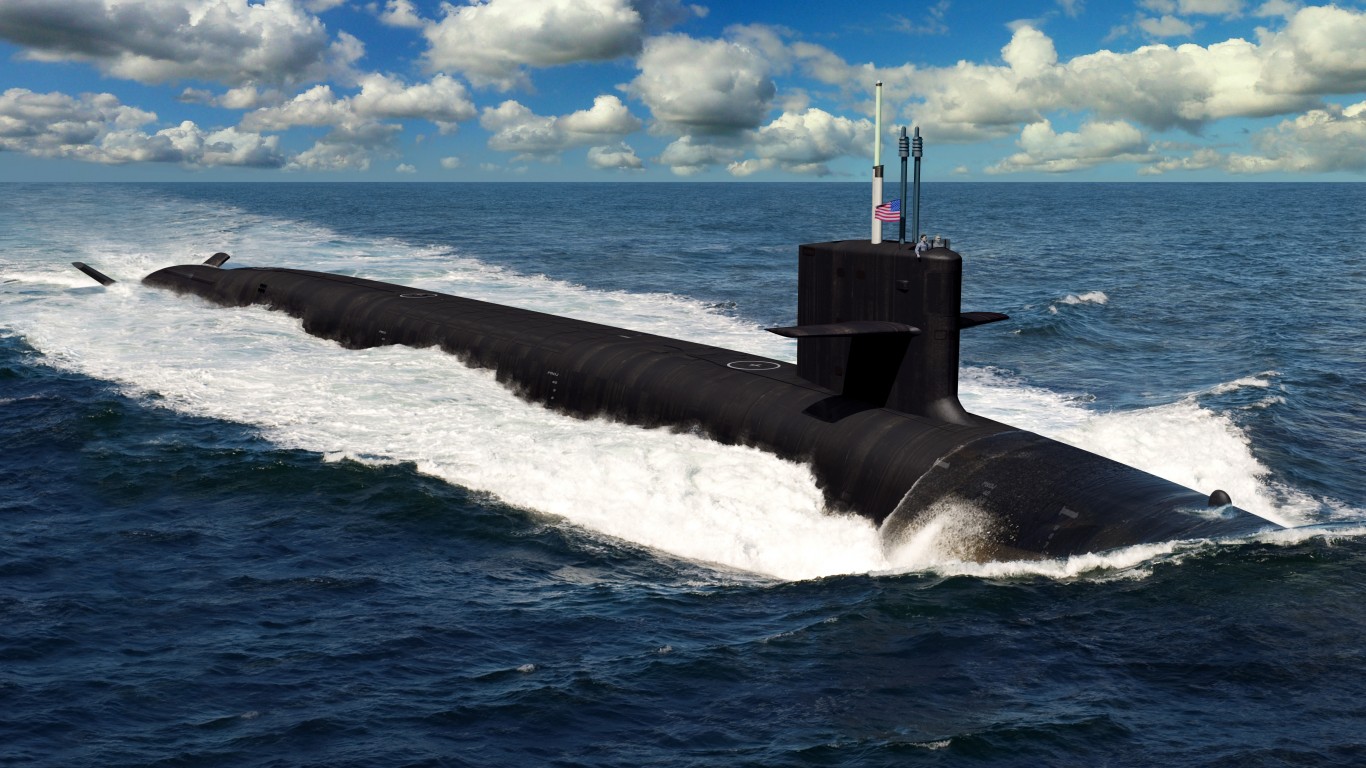
3. SSBN 826 Columbia Class Ballistic Missile Submarine
> Requested budget for 2024: $6.2 billion
> Budget for 2023: $6.3 billion
> Requested acquisitions, FY2024: 1 unit
> Acquisitions, FY2023: None
> Service branches: Navy
> Primary contractor(s): General Dynamics Corporation, Huntington Ingalls Industries
Department of Defense: “Funds the first two increments of the second boat (SSBN 827), future boats’ advance procurement, and detail design and construction of Contractor Furnished Equipment (CFE) and Government Furnished Equipment (GFE). Advance procurement includes CFE and GFE Long Lead Time Material; continuous production of missile tubes; advance construction; Economic Order Quantity for multi-program procurement; and continuous production of shipyard manufactured items. FY 2024 also continues funding research and development of nuclear technologies and ship systems such as the propulsion system, combat systems technology, and CMC. The request also supports the submarine industrial base and supplier development to reduce the Columbia class’s construction schedule risk.”

2. SSN 774 Virginia Class Submarine
> Requested budget for 2024: $10.8 billion
> Budget for 2023: $7.3 billion
> Requested acquisitions, FY2024: 2 units
> Acquisitions, FY2023: 2 units
> Service branches: Navy
> Primary contractor(s): General Dynamics Corporation, Huntington Ingalls Industries
Department of Defense: “Funds two additional Block V boats… The FY 2024 request also funds advance procurement for four boats in future years… and outfitting and support equipment. FY 2024 continues funding development of the VPM technology, prototype components, and systems engineering required for design and construction.”
[in-text-ad-2]
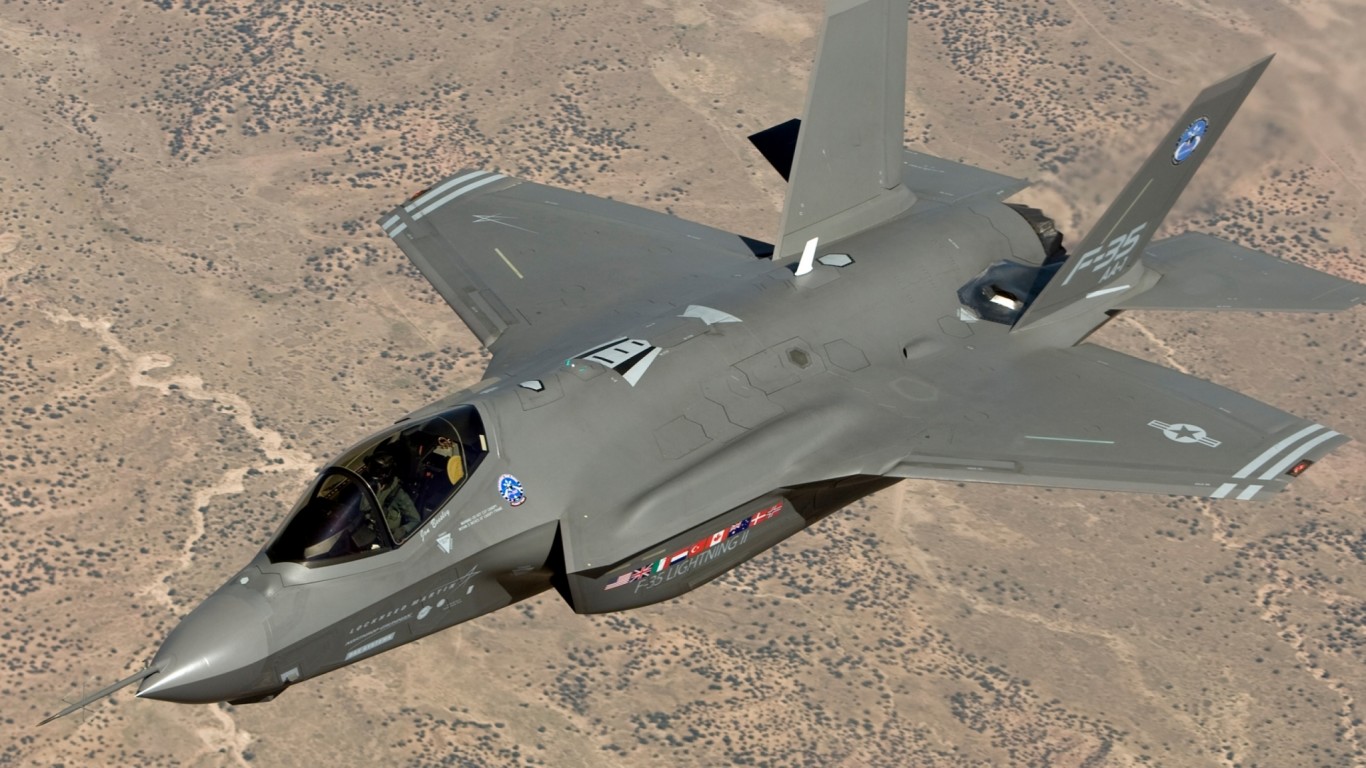
1. F-35 Joint Strike Fighter
> Requested budget for 2024: $13.6 billion
> Budget for 2023: $11.9 billion
> Requested acquisitions, FY2024: 83 units (35 for U.S. Navy/Marines, 48 for Air Force)
> Acquisitions, FY2023: 77 units (34 for U.S. Navy/Marines, 43 for Air Force)
> Service branches: Joint service
> Primary contractor(s): Lockheed Martin Corporation. Pratt & Whitney
Department of Defense: “Continues systems engineering, development and operational testing, and supports Continuous Capability Development and Delivery (C2D2) to provide incremental warfighting capability improvements to maintain joint air dominance against evolving threats… Continues laying down the ground and squadron support and site stand-up infrastructure required to support U.S. Services F-35 air systems. Accelerates an organic depot maintenance capability to reduce depot repair cycle times to improve air vehicle availability rates.”
The Average American Is Losing Momentum On Their Savings Every Day (Sponsor)
If you’re like many Americans and keep your money ‘safe’ in a checking or savings account, think again. The average yield on a savings account is a paltry .4%1 today. Checking accounts are even worse.
But there is good news. To win qualified customers, some accounts are paying more than 7x the national average. That’s an incredible way to keep your money safe and earn more at the same time. Our top pick for high yield savings accounts includes other benefits as well. You can earn up to 4.00% with a Checking & Savings Account today Sign up and get up to $300 with direct deposit. No account fees. FDIC Insured.
Click here to see how much more you could be earning on your savings today. It takes just a few minutes to open an account to make your money work for you.
Thank you for reading! Have some feedback for us?
Contact the 24/7 Wall St. editorial team.